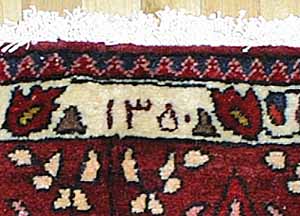Islamic Dates in OLDER Carpets
Rugs woven and dated in the 17th, 18th, and 19th Centuries almost always use the Islamic lunar calendar. To convert an Islamic lunar date into the Christian or Georgian date, use this formula:
Islamic lunar date + 622 - (Islamic lunar date/33.7) =
Christian date
Thus, a woven rug date of "1280" converts like this: Islamic lunar
date of 1280 plus 622 minus 38 (38 being 1280 divided by 33.7) = Christian date
of 1864
Islamic Dates in NEWER Carpets
By the 1920's, the governments of both Turkey and "Persia" (which changed its name to Iran at this time) converted to a solar calendar, so that the lengths of their months would match the lengths of months in the West (note that the Caucasus, under Russian control since the early 1800's, tended to use the solar calendar earlier than Turkey or Iran). Year One was still reckoned from the Hegira, Muhammad's flight from Mecca to Medina in 622AD. To convert an Islamic solar date into the Christian or Georgian date, use this formula:
Islamic solar date + 622 = Christian date [no lunar conversion
factor is needed]
(Note that this conversion is not completely accurate, as the Islamic
and Christian new years occur at different times.)
Thus, a woven rug date of "1376" converts like this: Islamic solar
date of 1376 + 622 = Christian date of 1998
Arabic Numerals Used in Dating Rugs
Western-style numerals are in red; three versions of numbers in Arabic
calligraphy are illustrated below them. Arabic numerals are read left-to-right,
as in the West: thousands, hundreds, tens, ones.
OK, enough lecture. Pictured here is part of a Bahktiari rug from Iran with a date woven into the guard border. Pick out the Arabic numbers that make up the date. Now change the Islamic date into western numbers, and convert the Islamic date into the Christian date (HEAVY HINT: this is a new-looking rug; it almost certainly was woven after WWII):
